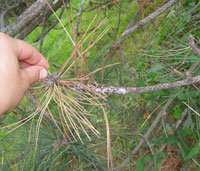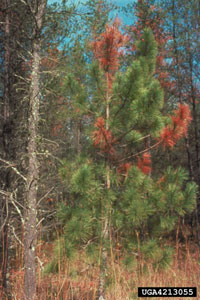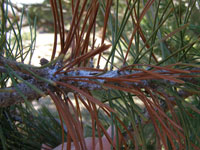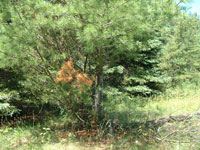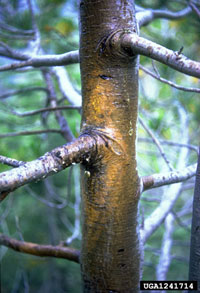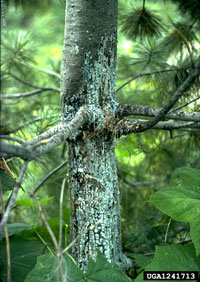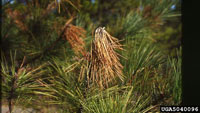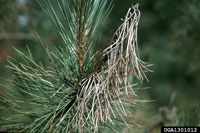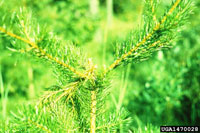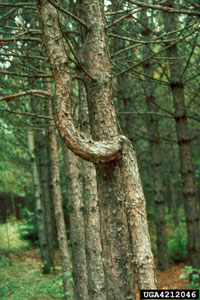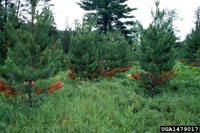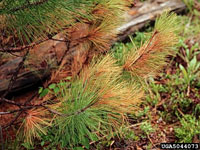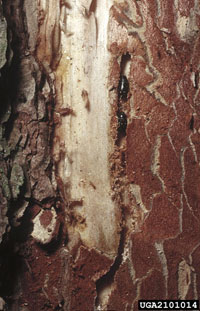Extension > Garden > Diagnose a problem > What's wrong with my plant? > Evergreen Trees and Shrubs > Pine > Needles on one to a few branches die
Pine > Needles > All needles on one to a few branches turn brown and die
1 of 6
Diplodia shoot blight
Diplodia pinea
- New needles are brown, short and often glued together with resin
- Cankers are resin coated flattened areas on branches
- Needles and branch beyond canker turn brown and dies
- Tiny, black, pimple-like fungal structures on dead needles and pine cones
- Infected shoots and dead branches occur throughout the tree but most commonly in the lower canopy
- Cankers and dead needles can appear rapidly after wounding from hail, drought or other stress
- Olive to dark brown streaking in sapwood below cankers
- Common on Austrian, red and Scots pine
- More information on Diplodia shoot blight
2 of 6
White pine blister rust
Cronartium ribicola
- All needles on one or several branches die and turn completely reddish-orange
- Young cankers are elliptical, bark appears swollen and discolored yellowish orange
- Older cankers exude large amounts of white sticky resin and have cracked bark
- In early spring, orange-yellow blisters appear on the bark of cankers that are 2 or more years old
- In summer, yellow-orange sticky liquid droplets form in cankers 3 years or older
- Only white pine and other five needled pines can be infected
- More information on White pine blister rust
3 of 6
Sirococcus shoot blight
Sirococcus conigenus
- Needles turn brown, wilt and droop
- Young shoots wilt and curl into a shepherd's crook
- Brown to black raised bumps can be seen on wilted needles and on shoots at the base of the needle in the fall or spring following the appearance of symptoms
- Older needles remain unaffected
- Common in cool, wet summers
- Infection often starts in the lower branches and moves up
- Common on red, jack and Scots pine; Austrian and eastern white pine are resistant
- Also infects spruce, fir and larch
- More information on Sirococcus shoot blight
4 of 6
Eastern pine shoot borer
Eucosma gloriola
- Wilted or drooping shoots form a shepherd's crook which often break off
- Needles beyond feeding sites first turn yellow then reddish-brown
- Needles may drop prematurely
- Larva is off-white with dark head and grows to about ½ inch long
- Small, oval exit hole may be seen below dying shoot
- Prefers white and Scots pine
- More information on Eastern pine shoot borer
5 of 6
Scleroderris canker
Gremmeniella abietina
- Needle clusters turn brown from the base up and are easily pulled off the branch
- Infected needles fall off in summer
- Buds on infected twigs fail to open
- Cutting into branch below discolored needles reveals yellow-green discoloration
- Cankers can kill branches or move into main stem and become perennial
- Damage is greatest on small (
- Jack and red pine most commonly affected
- More information on Scleroderris canker
6 of 6
Pine shoot beetle
Tomicus piniperda
- Dying, dead and broken shoots, particularly in the top half of the tree
- Adults tunnel into shoots which turn yellow to reddish-brown
- Attacks most pine species where cut stumps or logs are present
- Adults are shiny, black and about the size of a match head
- Larvae are white with a brown head and about ¼ inch long
- More information on Pine shoot beetle



